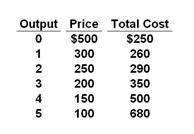If the government reduced the minimum wage and pursued expansionary monetary policy, then in the long run
a. both the unemployment rate and the inflation rate would be higher.
b. both the unemployment rate and the inflation rate would be lower.
c. the unemployment rate would be higher and the inflation rate would be lower.
d. the unemployment rate would be lower and the inflation rate would be higher.
d
You might also like to view...
A firm produces a good and generates $5 million in receipts. Wages are $3 million, rent is $500,000, and interest payments are $1 million. Then
A) profits are $500,000, the cost of production is $4.5 million, and households receive income equal to $4.5 million. B) profits are $500,000, the cost of production is $5 million, and households receive income equal to $4.5 million. C) profits are $500,000, the cost of production is $5 million, and households receive income equal to $3.5 million. D) profits are $500,000, the cost of production is $5 million, and households receive income equal to $5 million.
The M-Form of corporate organization
a. organizes employees along the functions or tasks that they perform b. organizes employees along the customer types that they serve c. organizes employees along individual projects that arise d. organizes employees into softball teams
A monthly growth rate of 0.5% is an annual growth rate of:
A. 6.50% B. 6.17% C. 5.00% D. 6.00%
Refer to the table below for a monopolist. If the monopolist perfectly price-discriminated and sold each unit of the product at the maximum price the buyer of that unit would be willing to pay, and if the monopolist sold 4 units, then total profits would be:
The following question is based on the demand and cost data for a pure monopolist given in the table below.

A. $100
B. $900
C. $150
D. $400